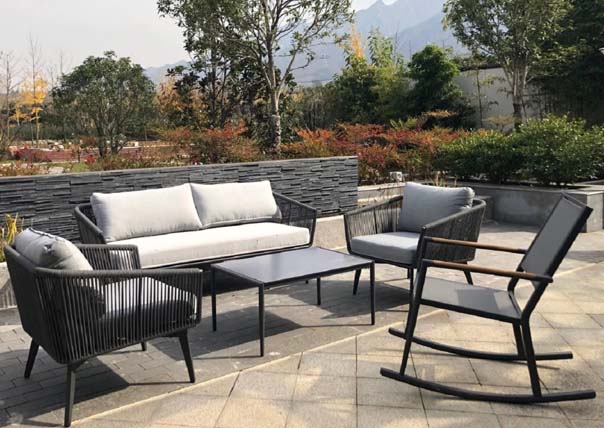How to Deep Clean Every Type of Outdoor Furniture?
It is recommended that your patio furniture is deep cleaned at least twice a year: once in the spring, then as the temperature rises start to use it regularly, and again in the autumn, before putting it all away for the winter. With proper care and maintenance, your furniture should provide years of comfort and pleasure for your outdoor living space.
Metal furniture
Aluminium, iron, steel and other metals can be forged (heated and hammered into shape), cast from a mould (usually solid pieces) or formed into hollow tubes. Because most metal furniture, with the exception of aluminium, will rust, metal furniture is usually coated with a clear varnish, paint or a durable powder coating.
Use a mild soap solution and scrub, rinse and dry according to the instructions. To remove rust or mould, gently sand the area with fine sandpaper. Wipe it clean and apply a few thin coats if required (available from the furniture manufacturer). Allow drying between coats. Humidity may affect the paint, so it is best to work on a dry day.
Outdoor Furniture
Wicker furniture
The flexible weave used to make furniture is traditionally made from rattan, reeds or coated paper, sometimes reinforced with metal. Clear varnish, paint or a combination of both are often used to protect the surface. Sunlight is the main enemy of wicker. If you intend to leave wicker furniture outside for more than two to three weeks, be sure to keep it covered.
To remove dirt and debris, vacuum with a dusting brush attachment or use a dry paintbrush. Clean with a mild soap solution. Scrub and rinse. Avoid using too much water, which can weaken the fibres. Dry as described.
Fabric furniture
Materials for outdoor use often called performance fabrics are designed to resist sun damage, stains, moisture and mildew. Solution-dyed fabrics woven from pigment-infused fibres are less likely to fade and are better able to handle more aggressive cleaning agents than printed or piece-dyed fabrics. To determine which ones you have, examine both sides of the fabric. If they are identical, it is probably solution dyed. Otherwise, it is printed or dyed.
Sometimes you can machine wash removable covers in cold water using mild unbleached laundry soap, then air dry. To hand wash, immerse the fabric in a solution of 1/4 cup mild liquid soap (such as Ivory) and 1 gallon of warm water (no more than 100 degrees), shaking gently. Rinse well and air dry.
To clean mildew from solution-dyed fabrics, mix 1 gallon of warm water with 2 tablespoons of oxygen bleach if it is listed as an approved cleaner in the care guide. Wet the affected area and scrub with a soft bristle brush. Rinse well and air dry.
Outdoor Furniture
Plastic furniture
Resin or all-weather furniture is usually made of plastic, either polyvinyl chloride (PVC) or polyethylene (PE). These plastics are made from a variety of chemical additives, including UV stabilisers and fungicides, and can be shaped to mimic items such as wood, wicker and woven chair straps and slings.
Use a mild soap solution and scrub, rinse and dry according to instructions. For stubborn stains or mould, try a solution of 10 parts water to 1 part chlorine bleach if the care instructions list bleach as an approved cleaning agent.
Wooden furniture
Most wood used for outdoor furniture is naturally resistant to decay and withstands the elements. Although sealers help to retain colour and prevent wear, they are not essential. Unfinished wood will have a silvery-grey sheen and will require little maintenance.
To remove stains or mildew, mix 1 gallon of hot water with powdered oxygen bleach according to the instructions. Scrub the area with a soft bristle brush and rinse well. To remove rust or bird droppings, or to restore the original colour, lightly sand along the grain with fine sandpaper and rinse well. If the area is too large to sand, mix hot water with oxalic acid crystals (also known as wood bleach or wood whitener) according to the instructions. Apply with a soft bristle brush and rinse well. Do not use chlorine bleach as this can damage the wood fibres.









